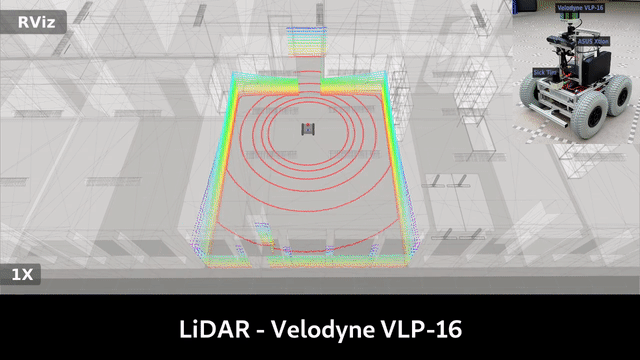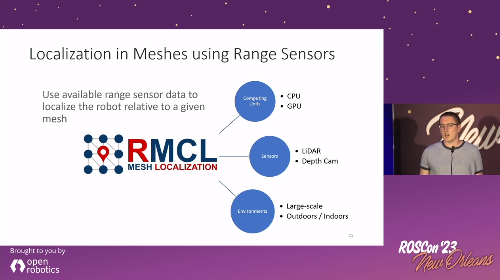This repository contains algorithms designed for map-based robot localization, specifically when dealing with maps composed of triangle meshes or complete scene graphs. These maps may be provided by architects who have designed the building in which the robot operates, or they can be autonomously generated by the robot through Simultaneous Localization and Mapping (SLAM) methods. It's crucial to note that map-based localization differs from SLAM; it focuses on estimating the robot's pose within a potentially large map, whether the initial pose is roughly known (tracking) or entirely unknown from the start aka kidnapped robot problem. Map-based localization is essential for precisely planning the robot's missions in a given map.
MICP-L: Mesh ICP for Robot Localization using Hardware-Accelerated Ray Casting. An approach to directly register range sensor data to a mesh in order to localize a mobile robot using hardware-accelerated ray casting correspondences (See publications).
| Hilti: 6DoF Localization | MulRan: Large-scale scenes |
|---|---|
 |
 |
Requirements:
- At least one range sensor equipped and running
- Triangle mesh as map
- Prior odometry estimation of the robot given as TF
IMU prior is also possible as long as it is integrated as TF-Transform, e.g. with Madgwick Filter.
- Title: "MICP-L: Mesh-based ICP for Robot Localization using Hardware-Accelerated Ray Casting"
- Preprint: https://arxiv.org/abs/2210.13904
- Experiments: https://github.com/aock/micp_experiments (only available with ROS-noetic)
The micp_localization Node starts the process of localizing the robot in a mesh using MICP and a given pose estimate.
It is usually started through a launch file since it requires a large set of parameters.
The following Launch-File
<launch>
<node pkg="rmcl" exec="micp_localization" name="micp_localization" output="screen">
<param name="map_file" value="/path/to/mesh/map.dae" />
<param from="/path/to/config/file.yaml" />
<remap from="pose_wc" to="/initialpose" />
</node>
</launch>runs the MICP localization node. After that a pose has to be given, e.g. by the RViz "2D Pose Estimate" Tool that publishes the results on the /initialpose topic.
Doing that, make sure to set the fixed frame to the map coordinate system.
RMCL itself doesn't provide any tools to visualize the maps (triangle meshes).
If you want to see the map in RViz, use for example the rviz_mesh_tools_plugins of the mesh_tools.
Once the launch file is started, the output in Terminal should look as follows:
Combining Unit: CPU
MICP initiailized
-------------------------
--- BACKENDS ---
-------------------------
Available computing units:
- CPU
- GPU
Available raytracing backends:
- Embree (CPU)
- Optix (GPU)
MICP load params
-------------------------
--- FRAMES ---
-------------------------
- base: base_footprint
- odom: odom
- base -> odom: yes
- map: map
Estimating: base_footprint -> map
Providing: odom -> map
-------------------------
--- SENSORS ---
-------------------------
- velodyne
- data: Topic
- topic: /velodyne_points
- msg: sensor_msgs/PointCloud2
- data: yes
- frame: velodyne
- model: Params
- type: spherical - loaded
- micp:
- backend: embree
MICP load params - done. Valid Sensors: 1
Waiting for pose guess...At startup, MICP does a few sanity checks for the input parameters.
Every possible mistake in configuration can then be inferred by this output.
For example, once there is no data available on the given PointCloud2-Topic it will print data: no instead.
The following sections describe example configuration files.
More example files for configuration are placed in the config/examples.
MICP Localization using a 3D LiDAR and doing the MICP steps completely on the CPU. Here the 3D LiDAR is a Velodyne VLP-16 with 16 scan lines. The horizontal number of points is reduced to 440 and might be adjusted for your own Velodyne.
File: `config/examples/micp_velodyne_cpu.yaml`
# required
base_frame: base_footprint
map_frame: map
odom_frame: odom
# rate of broadcasting tf transformations
tf_rate: 50.0
invert_tf: False
micp:
# merging on gpu or cpu
combining_unit: cpu
# maximum number of correction steps per second
# lower this to decrease the correction speed but save energy
corr_rate_max: 1000.0
print_corr_rate: False
# adjust max distance dependend of the state of localization
# helps to continuously disregard objects that not exist in the map
adaptive_max_dist: True # enable adaptive max dist
# offset added to inital pose guess
trans: [0.0, 0.0, 0.0]
rot: [0.0, 0.0, 0.0] # euler angles (3) or quaternion (4)
# describe your sensor setup here
sensors: # list of range sensors - at least one is required
velodyne:
topic: velodyne_points
# spherical is comparable to sensor_msgs::msg::LaserScan
# but in 3D
type: spherical
model:
range_min: 0.5
range_max: 130.0
phi_min: -0.261799067259
phi_inc: 0.03490658503988659
phi_n: 16
theta_min: -3.14159011841
theta_inc: 0.01431249500496489
theta_n: 440
micp:
max_dist: 1.0
# Once adaptive_max_dist is set to true:
#
# If the localization is perfect, the max
# distance for finding SPCs is reduced to
# `adaptive_max_dist_min`.
# If the localization is bad, the max
# distance for finding SPCs is raised to
# `max_dist`
adaptive_max_dist_min: 0.15
backend: embreeMICP also supports to localize a robot only equipped with a 2D LiDAR in a 3D map.
To correct the third dimension the wheels can be used to pull the robot towards the map's ground plane.
Thus, you should only run it on a robot that always drives on the ground and e.g. cannot fly.
In this example, all MICP steps are computed on GPU.
The robot has four wheels of which the highest points are located relative to base_footprint as listed in origs.
By setting a virtual scanner to the wheel positions scanning downwards with a constant scanning range equal to the wheel diameter it is possible to pull the robot to the mesh.
File: `config/examples/micp_sick_gpu.yaml`
# required
base_frame: base_footprint
map_frame: map
odom_frame: odom
# rate of broadcasting tf transformations
tf_rate: 50.0
micp:
# merging on gpu or cpu
combining_unit: gpu
# maximum number of correction steps per second
# lower this to decrease the correction speed but save energy
corr_rate_max: 1000.0
print_corr_rate: False
# adjust max distance dependend of the state of localization
adaptive_max_dist: True # enable adaptive max dist
# offset added to initial pose guess
trans: [0.0, 0.0, 0.0]
rot: [0.0, 0.0, 0.0] # euler angles (3) or quaternion (4)
# describe your sensor setup here
sensors: # list of range sensors - at least one is required
sick:
topic: scan
micp:
weight: 1.0
backend: optix
wheels: # pull robot to the mesh
ranges: [0.2, 0.2, 0.2, 0.2]
type: ondn
frame: base_footprint
model:
width: 4
height: 1
range_min: 0.0
range_max: 10.0
origs: [[ 0.2, 0.15, 0.2], # front left
[ 0.2, -0.15, 0.2], # front right
[-0.2, 0.15, 0.2], # rear left
[-0.2, -0.15, 0.2]] # rear right
dirs: [[ 0.0, 0.0, -1.0],
[ 0.0, 0.0, -1.0],
[ 0.0, 0.0, -1.0],
[ 0.0, 0.0, -1.0]]
micp:
max_dist: 1.0
adaptive_max_dist_min: 0.2
weight: 1.0
backend: optixDependencies:
- Download and install Rmagine (v > 2.2.0): Compile from source (not debian packages).
- Recommended: Install OptiX backend if NVIDIA GPU is available
- For rmagine version >= 2.2.2 it is possible to put rmagine into your ROS workspace for easier compilation
- ROS2 (check compatible branches)
- Clone rmcl_msgs to your workspace
Clone this repository into your ROS workspace and build it.
To learn how to use RMCL ROS nodes in your project, visit https://github.com/aock/rmcl_example.
To learn how to use RMCL library in your Node: src/nodes/examples.
To navigate a robot automatically and safely through uneven terrain, the combination RMCL + Mesh Navigation Stack is very suitable: https://github.com/naturerobots/mesh_navigation. As we presented on ROSCon 2023:
This package will be expanded by more functionalities to localize a robot in mesh maps. The planned Roadmap is as follows:
- MICP-L (Tracking)
- RMCL (Global Localization)
The main branch is humble now! Since it is not backwards compatible we decided to increase the version of RMCL to 2.0.0. The noetic version will still exist with the "noetic" branch. The "noetic" branch will be maintained until the end of 2024.
The first ROS2 port has been released! If you are using ROS2, check out the humble branch of this and all linked repositories. After the new branch has been tested well enough, I will make it the main branch. The current version will persist in the noetic branch.


